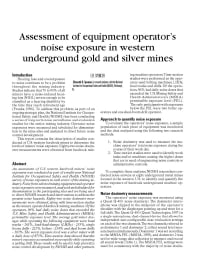Mining Publication: Assessment of Equipment Operator's Noise Exposure in Western Underground Gold and Silver Mines
Original creation date: March 2010
Authors: ER Spencer
An assessment of U.S. western hard-rock miners' noise exposures was conducted as part of a multi-year National Institute for Occupational Safety and Health (NIOSH) survey of noise exposures in each sector of the mining industry. Noise from selected mining equipment and operator noise exposures were measured, analyzed, and tabulated for dissemination to the participating sites and are being used to direct NIOSH research and interventions to address the greatest noise hazards. Eighty-two noise dosimeter measurements were obtained, along with time-motion studies as the miners operated hard-rock mining machines. Ninety-six percent of the operators had daily noise doses that exceeded the Mine Safety and Health Administration’s permissible exposure level. The average gold miner dosages while operating the following equipment were: haul trucks - 261%, load-haul-dumps (LHDs) - 235%, single boom drills - 221%, bolters - 214%, and dual boom drills - 163%. The worst exposure level was a silver miner with a daily dose of 873%. Time-motion data showed that this miner’s exposure accumulated most rapidly while operating a jack-leg drill. These results will be used to help prioritize noise control development by NIOSH and other partners.

- Determination of Sound Exposures (DOSES): Software Manual and Implementation Guide
- Development of the NIOSH Determination of Sound Exposures (DOSES) Mining Noise Exposure Management Software
- DOSES - Determination of Sound Exposures - 1.1
- Drill Rig Incident
- Noise and Hearing Protection: Development of Two Training Exercises for Drillers
- Noise Exposure and Overhead Power Line (OPL) Safety Hazards at Surface Drilling Sites
- Technology News 536 - NIOSH Develops New Software to Analyze and Reduce Noise Exposure
- Technology News 538: Acoustic Enclosure to Reduce Noise From Vibrating Screen Mechanism Housings
- What Does a Hearing Loss Sound Like?
- Working in Noise with a Hearing Loss: Perceptions from Workers, Supervisors, and Hearing Conservation Program Managers